Penduline Tit - Lowestoft © Andrew Easton The AMERICAN BITTERN was still present on the 28th at least though the weather was not helping viewing. |
| If you wish to
receive local bird news messages you can now
follow @LowestoftLizard on Twitter. Follow @LowestoftLizard UPDATED: 22:30 29th April |
SUFFOLK WILDLIFE TRUST SUFFOLK BROADS APPEAL |
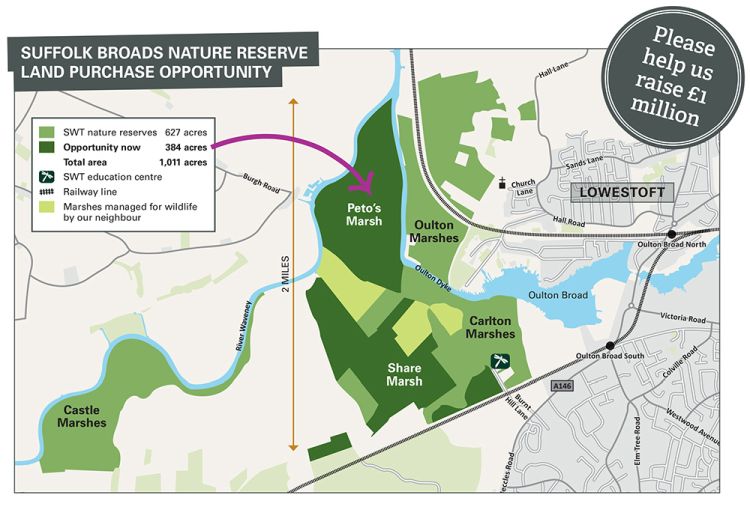 |
|
Regular readers will have noticed sightings from Carlton and Oulton Marshes appearing increasingly frequently over the last four years. This increase has been brought about by the creation of scrapes in small, formerly just grass, fields on both of these reserves by the SWT Broads Warden Matt Gooch and his dedicated team of volunteers. -++++++++++++++++++++++++++++++++++++++++++++++++++++++++++++++++++++++++++-++-++, Waders and wildfowl that formerly just flew over, or at best maybe stopped off to feed in a ditch for a few hours, now often stay for days in these newly created havens. Shoveler, Lapwing and Redshank are now successfully rearing young around these scrape fields. For years we in Lowestoft we have dreamed that Peto's Marsh might one day be brought back to life as a nature reserve and now this dream is within sight, with the added bonus of Share Marsh also becoming available to purchase at the same time. The plans are to create a new reedbed, which will be the largest in the Broads, and new scrapes and dykes. All that is needed now are the funds to buy the land and begin the restoration of this corner of the Broads. Clicking on the map above will open a new window to take you to the Suffolk Wildlife Trusts Suffolk Broads Appeal pages, with more details of their vision for the area and their donation page. Please donate what you can to help make views like that below become regular sights in a premier nature reserve on the outskirts of Lowestoft. |
 |
| Carlton Marshes - 11th May 2016 Two Spoonbills feed on the new scrape while two belligerent Little Egrets argue over territory in the background. |
RED-THROATED DIVER Gavia stellata
Oulton Broad - 1st (1).
Corton - 16th (1 N).
SHAG Phalacrocorax aristotelis
Lake Lothing - 3rd (1), 4th (1).
FULMAR Fulmarus glacialis
Ness Point - 28th (1 S), 29th (1 N).
AMERICAN BITTERN Botaurus lentignosus
The most unexpected bird of the year (to date) was the American Bittern photographed twice on the 7th at Carlton Marshes (thought it seems from earlier photos that it has been present since at least March 30th).
The waiting crowds on the 8th were finally rewarded at 12:32 when it took to the skies chased by a Eurasian Bittern. It made a couple more flights over Share Marsh during the afternoon, and made one quick walk across a relatively open area between two stands of reed.
It was still still present on the 9th but proved more elusive, after being seen in flight at 08:30 it was not seen again until late afternoon when it was relocated on the southern corner of Share Marsh before flying back towards its previously favoured area in the company of a Eurasian Bittern.
It became more adventurous on the 10th wandering north to Peto's Marsh for the first time, and many people had views on the ground rather than just in flight. The cameras from ITV Anglia were on site trying to capture it as well.
On the 11th persistent heavy mist that hung around throughout the whole day severely hampered viewing and it wasn't until late afternoon that it was spotted dropping into reeds at the south west corner of Share Marsh. Luckily most observers still on site managed to get round in time to see it fly out and head north west over Share Marsh before dropping back in near the scrape. It was subsequently seen briefly walking along the reed edge of the field behind the concrete bridge at the scrape. A distant bittern later seen flying further towards, but not to, the river was probably the American Bittern as it has tended to visit the last field on Share Marsh nearest the river towards dusk on previous days.
Heavy mist throughout the day on the 12th drastically reduced visibility and there were no sightings of the American Bittern, but it proved to still be present on the 13th.
On the 14th it flew in at 10:55 from the Barnby direction which, if it heads of that way each morning, could explain the general lack of morning sightings to date. It was later seen briefly a few times on the ground from the Share Marsh track but was generally pretty elusive. Later in the evening it flew around a couple of times, accompanied this time by two Eurasian Bitterns providing a handy direct comparison again.
After a sighting at 07:15 on the 15th (accompanying two Eurasian Bitterns), and largely due to heavy mist, there were no further sightings until 14:37 when it flew around again over Share Marsh. Soon afterwards it was spotted on the ground with the two Eurasian Bitterns and was then watched chasing around displaying to one of them, producing a large fan of white feathers from the breast sides creating two very striking epaulettes over the bend of the wings. These white patches were still visible when it was chasing the Eurasian Bittern in flight.
On the 16th it was only seen very briefly in flight three times between 19:15 and 19:23. Still present to the 21st, it remains as erratic as ever in its appearances.
On the afternoons of the 20th and 21st it was seen feeding along the edges of a dyke running across Share Marsh behind the scrape. On the 21st it was also watched swimming across the same dyke.
Still present on the 22nd, and although it remains as erratic as ever in its appearances, since the water levels in the dykes have been raised, for the last three days it has been observed feeding along and swimming across the dyke running back across Share Marsh behind the scrape field, and showed well there in the evening on the 22nd at least.
On the 23rd it was seen feeding around the edge of the dyke behind the scrape in the afternoon, and in the evening it returned and fed there for nearly two hours.
On the 24th it again performed well in the dyke behind the scrape in the late afternoon and evening.
On the 25th the only sighting was an evening flight view. The favoured dyke was heavily rippled due to the wind blowing down it and it was speculated that this would have made it difficult to see potential prey and the bittern was seeking out more sheltered dykes as a result.
On the evening of the 26th it was viewable from the river wall as it fed along the boundary dyke of Share Marsh. Still present on the 27th and 28th at least but the weather wasn't helping viewing.
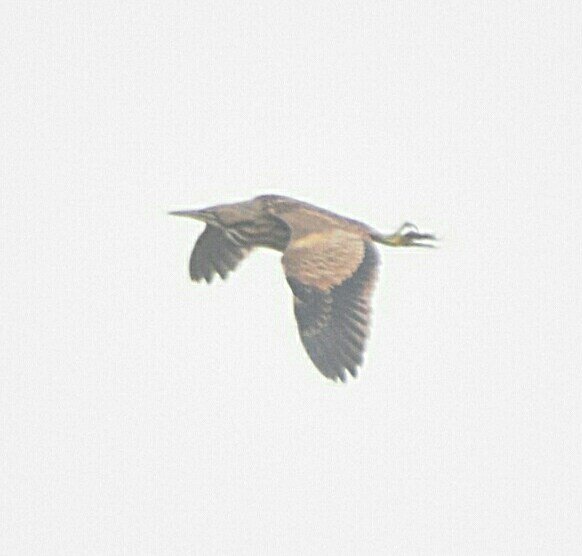 |
 |
| American
Bittern
-
Carlton
Marshes © Rene Baptiste |
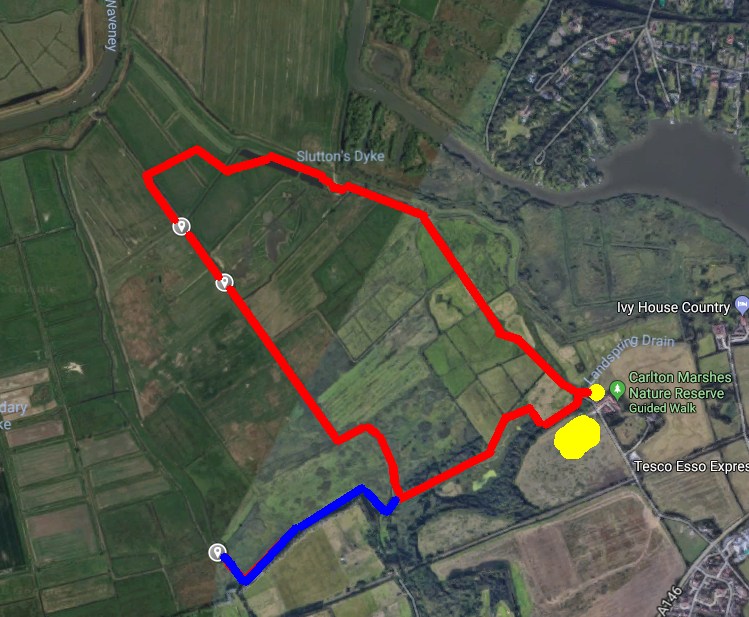 |
| On most days it has favoured the same
area of Share Marsh to the south and west of the
grey location markers around grid reference TM496925
on the map above. This is reached by a circular path
that although muddy in places is now starting to dry
out. It is also sometimes seen in the fields in the southern corner of the march near the end of the long row of obvious tall poplar trees, this section is reached by the path marked in blue that has VERY wet and boggy sections. Parking areas are marked in yellow. |
 |
| American
(right)
& Eurasian
Bittern
-
Carlton
Marshes © Andrew
Easton |
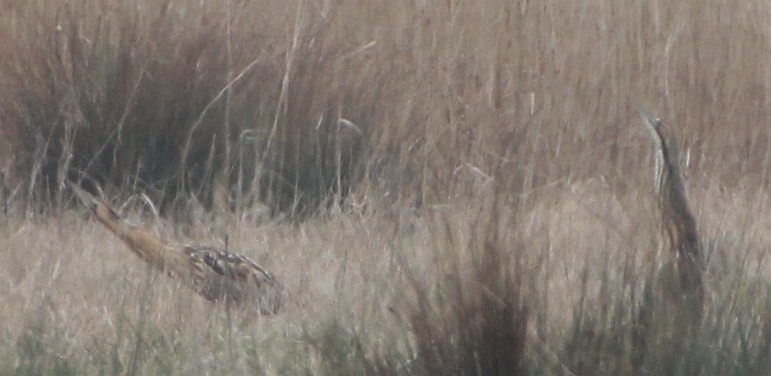 |
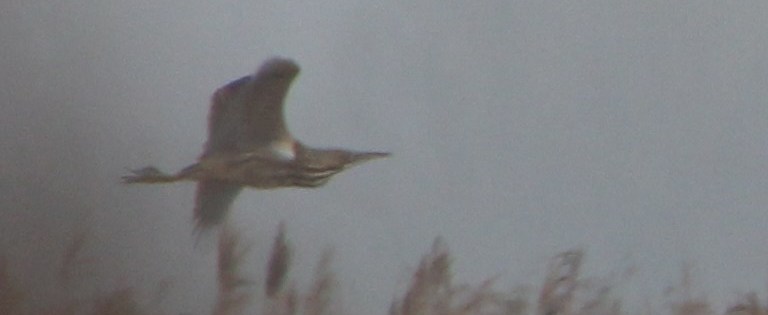 |
| American
Bittern
-
Carlton
Marshes © Andrew
Easton Showing the prominent white feathering on the breast side exposed during display. |
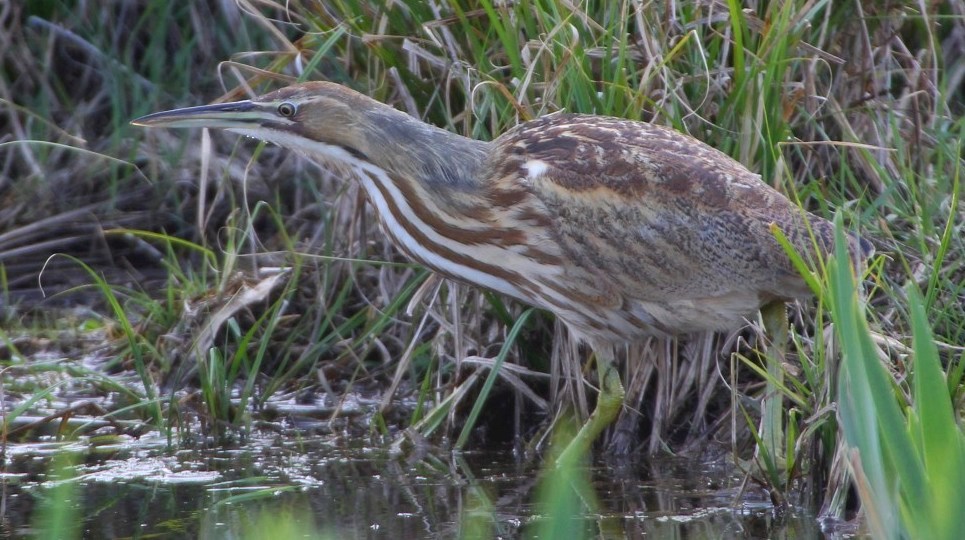 |
EURASIAN BITTERN Botaurus stellaris
Three were seen on the 6th, though with the events of the next day it seems highly likely that one of them was actually the AMERICAN BITTERN.
Two were also seen on the 8th, with one on the 9th, 11th and 12th at least. Two or three were seen and/or heard on the 14th, and two were seen on the 15th. At least one still present on the 21st at least.
LITTLE EGRET Egretta garzetta
Carlton Marshes - 4th (2), 5th (2), 6th (2), 8th (2), 9th (1), 14th (3).
Oulton Marshes - 5th (1).
GREAT WHITE EGRET Ardea alba
One was at Oulton Marshes on the 5th to 10th at least.
One flew north/north eastward over Carlton Marshes and Oulton Broad on the evening of the 19th.
SPOONBILL Platalea leucorodia
Pakefield - 14th (2 N).
Breydon Water - 14th (1 N).
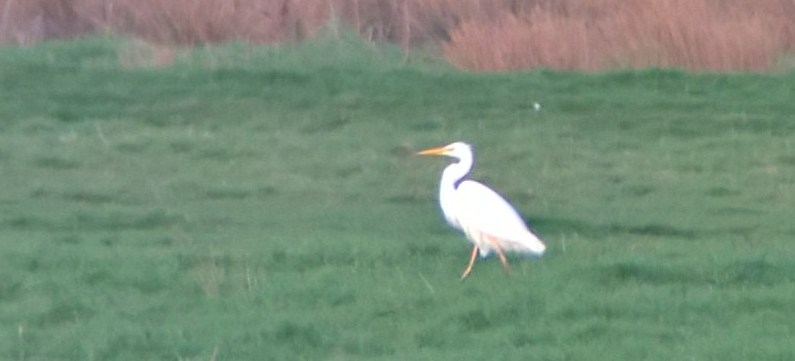 |
| Great
White Egret
-
Oulton Marshes (above)
- Carlton Marshes
(below)
© Andrew Easton |
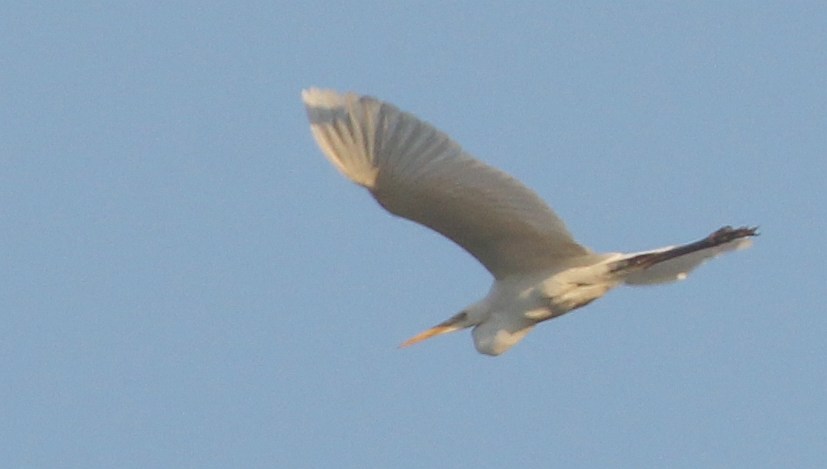 |
Carlton Marshes - 4th (14).
BARNACLE GOOSE Branta leucopsis
Carlton Marshes - 6th (1), 7th (1), 8th (5), 15th (1), 22nd (2).
SHELDUCK Tadorna tadorna
Carlton Marshes - 15th (3), 16th (2).
PINTAIL Anas acuta
Carlton Marshes - 10th (2).
TUFTED DUCK Aythya fuligula
Leathes Ham - 2nd (32), 4th (17), 29th (7).
Carlton Marshes - 8th (3), 9th (3), 21st (2), 22nd (2).
POCHARD Aythya ferina
Leathes Ham - 2nd (2 females), 3rd (2 - male & female), 4th (2 - male & female), 14th (male).
COMMON SCOTER Melanitta nigra
Kessingland - 2nd (60 on the sea).
Lake Lothing - 2nd (1), 3rd (1).
VELVET SCOTER Melanitta fusca
Lowestoft - 6th (1 S).
OSPREY Pandion haliaetus
One flew north west over Kessingland sewage works on the 1st.
One flew north over Denmark Road, Lowestoft at 17:15 on the 13th.
One flew over Carlton Marshes on the 19th.
RED KITE Milvus milvus
Corton (A47) - 5th (1).
St Olaves - 10th (1).
Station Road, Corton - 13th (1 S).
Morrisons (Pakefield) - 14th (1 N).
Carlton Marshes - 14th (1 SE), 28th (1 NNE).
Hulver - 22nd (1).
COMMON BUZZARD Buteo buteo
Corton (A47) - 5th (6).
Carlton Marshes - 5th (9+), 11th (1), 14th (8+).
Hopton - 5th (3).
St. Olaves - 17th (2).
MARSH HARRIER Circus aeruginosus
Carlton Marshes - 4th (2), 5th (5), 11th (2), 14th (11), 15th (6+), 16th (9).
Corton - 14th (2 S), 22nd (1).
HEN HARRIER Circus cyaneus
Carlton Marshes - 12th (1 male), 15th (male).
HOBBY Falco subbuteo
Castle Marshes, North Cove - 25th (1).
Pakefield - 28th (1 S).
Carlton Marshes - 28th (1).
WATER RAIL Rallus aquaticus
Leathes Ham - 2nd (3).
Oulton Marshes - 5th (1).
Carlton Marshes - 8th (2+), 10th (1), 14th (1), 15th (1).
CRANE Grus grus
Carlton Marshes - 14th (2 over), 20th (1 over).
AVOCET Recurvirosta avosetta
Carlton Marshes - 10th (2), 15th (2), 19th (2), 21st (8), 22nd (4), 24th (5), 25th (10).
OYSTERCATCHER Haematopus ostralegus
Corton - 5th (2).
Carlton Marshes - 14th (2), 15th (2), 21st (1).
Ness Point - 16th (1).
GOLDEN PLOVER Pluvialis apricaria
Oulton Marshes - 5th (1 over).
Carlton Marshes - 8th (1 over).
LITTLE RINGED PLOVER Charadrius dubius
Carlton Marshes - 7th (1), 14th (1), 21st (1), 24th (1).
PURPLE SANDPIPER Calidris maritima
Ness Point/Lowestoft North Beach - 3rd (9), 5th (6), 7th (4), 16th (5), 25th (1), 26th (7), 28th (3).
DUNLIN Calidris alpina
Carlton Marshes - 10th (1), 14th (1), 21st (1).
RUFF Philomachus pugnax
Carlton Marshes - 5th (1), 9th (2), 21st (1), 22nd (3).
SNIPE Gallinago gallinago
Carlton Marshes - 10th (10), 14th (12), 15th (c. 40), 16th (c. 29), 22nd (6), 25th (11).
JACK SNIPE Lymnocryptes minimus
Carlton Marshes - 10th (2), 12th (1), 24th (1).
WOODCOCK Scolopax rusticola
Pakefield - 9th (1 in off the sea).
Corton new sewage works - 12th (1).
GREENSHANK Tringa nebularia
Carlton Marshes - 10th (1), 21st (2), 25th (1).
Corton - 16th (1 S).
BLACK-TAILED GODWIT Limosa limosa
Carlton Marshes - 13th (23), 21st (4).
CURLEW Numenius arquata
Corton - 16th (2 S).
Carlton Marshes - 21st (1 over).
WHIMBREL Numenius phaeopeus
Carlton Marshes - 12th (2), 14th (1), 16th (2), 17th (1), 19th (1), 21st (1), 24th (1), 25th (1), 26th (12).
North Cove Marshes - 21st (8), 25th (19), 29th (21).
GREEN SANDPIPER Tringa ochropus
Pakefield/Kessingland Cliffs - 14th (1 N).
Corton old sewage works - 16th (1).
Carlton Marshes - 29th (1).
COMMON SANDPIPER Actitis hypoleucos
Pathways Farm - 23rd (1).
TURNSTONE Arenaria interpres
Ness Point - 16th (21), 26th (17).
 |
GREAT SKUA Skua skua
Kessingland - 6th (1).
YELLOW-LEGGED GULL Larus michahellis
Kessingland Levels - 2nd (1).
COMMON TERN Sterna hirundo
Oulton Broad - 2nd (1 flew to Lake Lothing), 27th (3).
SANDWICH TERN Sterna sandvichensis
Corton - 16th (1 N).
GUILLEMOT Uria aalge
Kessingland - 2nd (1 on the sea).
BARN OWL Tyto alba
Carlton Marshes - 4th (1), 9th (1), 14th (3), 15th (1).
SHORT-EARED OWL Asio flammeus
Kessingland Denes - 13th (1).
Pakefield/Kessingland Cliffs - 14th (1 S).
Carlton Marshes - 21st (1), 26th (1), 27th (1).
Oulton Marshes - 26th (1).
SWIFT Apus apus
Mutford - 21st (1).
Gunton - 24th (2).
Carlton Marshes - 25th (6), 28th (8).
Oulton Broad - 27th (2).
Kessingland - 28th (4).
CUCKOO Cuculus canorus
Carlton Marshes - 14th (1+), 17th (1), 19th (1).
Worlingham Wall - 21st (1).
Oulton Marshes - 22nd (2).
KINGFISHER Alcedo atthis
Carlton Marshes - 5th (1), 20th (1).
GREEN WOODPECKER Picus viridis
Lound Lakes - 5th (2).
GREAT SPOTTED WOODPECKER Dendrocopus major
St. Olaves - 17th (1).
SAND MARTIN Riparia riparia
Corton Cliffs - 3rd (3), 7th (4), 13th (9), 24th (10).
Carlton Marshes - 25th (2).
Leathes Ham - 29th (2).
SWALLOW Hirundo rustica
Gunton - 3rd (1).
Carlton Marshes - 3rd (5), 7th (1), 8th (3+), 14th (4+), 15th (6+), 16th (3).
Kessingland sewage works - 4th (1).
Corton Cliffs - 5th (1 N), 7th (4).
Rookery Close, Oulton Broad - 5th (1).
The Hollies, Kessingland - 6th (1).
Leathes Ham - 29th (40).
HOUSE MARTIN Delichon urbica
Stirrups Lane, Corton - 5th (1).
Carlton Marsh - 21st (2), 25th (2).
TREE PIPIT Anthus trivialis
Carlton Marshes - 14th (1 N).
Corton - 24th (1 N).
BLUE-HEADED WAGTAIL Motacilla flava flava
Carlton Marshes - 14th (1), 18th (1).
YELLOW WAGTAIL Motacilla flava flavissima
Carlton Marshes - 9th (3), 10th (1), 14th (1), 15th (1), 16th (5), 20th (4), 21st (3+), 22nd (2), 24th (1), 25th (1), 28th (3).
Corton Cliffs - 14th (1 in off the sea).
Denes Oval - 23rd (3).
WHITE WAGTAIL Motacilla alba alba
Corton - 4th (21), 5th (10+), 14th (3).
Oulton Marshes - 5th (1).
Riverside Road, Lowestoft - 24th (1).
Ness Point - 26th (1), 28th (1).
PIED WAGTAIL Motacilla alba yarrellii
Corton - 4th (4), 5th (3).
Kessingland sewage works - 5th (2).
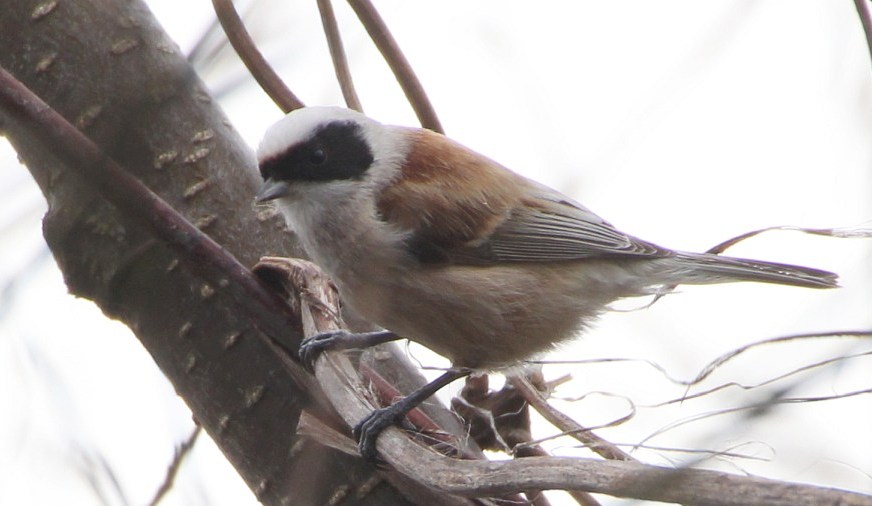 |
| Penduline
Tit
- Leathes
Ham- ©
Andrew Easton |
BLACK REDSTART Phoenicurus ochruros
Corton old sewage works - 4th (1), 5th (2), 6th (1), 16th (1).
Ness Point - 4th (1), 22nd (1).
Heritage Green, Kessingland - 5th (1),
London Road, Kessingland - 5th (1).
CEFAS Pakefield - 9th (1).
Kessingland Denes - 12th (4).
Corton new sewage works - 14th (1).
Corton Cliffs - 14th (1).
Parkhill - 16th (1).
Lowestoft North Denes - 22nd (1).
Commercial Road, Lowestoft - 22nd (1).
COMMON REDSTART Phoenicurus phoenicurus
Gunton disused railtrack - 15th & 16th (1 male).
Kirkley Cemetery - 25th (1).
WHINCHAT Saxicola rubetra
Carlton Marshes - 13th (1).
Kessingland Sluice - 29th (2).
WHEATEAR Oenanthe oenanthe
Kessingland Denes - 2nd (1), 12th (1), 14th (1), 26th (9), 29th (1).
Corton Cliffs - 3rd (1), 13th (2), 14th (4), 23rd (4).
Lowestoft North Denes - 5th (3), 16th (1), 22nd (5), 25th (5), 26th (8), 27th (6), 29th (3).
Breydon South Wall - 5th (1).
Pakefield Beach - 9th (1), 16th (4).
Carlton Marshes - 14th (1), 15th (1), 22nd (1), 25th (6), 28th (1).
Ness Point - 14th (1), 16th (1), 22nd (2).
Pakefield/Kessingland Cliffs - 14th (1).
Corton new sewage works - 20th (2), 21st (2).
Riverside Road, Lowestoft - 22nd (4), 23rd (4), 24th (4), 29th (5).
Blundeston - 26th (2).
Waveney Drive - 27th (1).
REDWING Turdus iliacus
Carlton Marshes - 11th (40), 13th (c. 30), 14th (50+).
Corton - 13th (5).
Pakefield/Kessingland Cliffs - 14th (10).
RING OUZEL Turdus torquatus
Carlton Marshes - 8th (1), 14th (2+).
Harpers Lane, Bradwell - 14th (3)., 22nd (1).
Corton new sewage works - 14th (2).
Corton old sewage works - 14th (1).
North Cove - 21st (1).
Riverside Road, Lowestoft - 22nd (1).
Corton old sewage works - 22nd (1).
Kessingland Sluice - 26th (1).
FIELDFARE Turdus pilaris
Carlton Marshes - 11th (4), 13th (c. 10), 14th (15).
Ellough - 12th (10).
Corton - 13th (6).
Pakefield/Kessingland Cliffs - 14th (20).
CETTI'S WARBLER Cettia cetti
Carlton Marshes - 4th (4), 8th (3), 10th (3), 14th (3+), 15th (3), 19th (4), 21st (8).
Oulton Marshes - 14th (1).
Boathouse Lane, Oulton Broad - 18th (1).
GRASSHOPPER WARBLER Locustella naevia
Carlton Marshes - 10th (1), 14th (1), 15th (1), 17th (3), 19th (4), 21st (4).
Fisher Row/Oulton Marshes - 14th (1).
North Cove Nature Reserve - 25th (1).
SEDGE WARBLER Acrocephalus schoenobaenus
Carlton Marshes - 8th (7+), 10th (4), 14th (10), 21st (29).
Kessingland sewage works - 14th (1).
Kessingland Sluice - 21st (3).
REED WARBLER Acrocephalus scirpaceus
Corton new sewage works - 13th (1), 17th (2), 21st (1).
Oulton Broad - 21st (1).
Carlton Marshes - 21st (1), 22nd (3).
BLACKCAP Sylvia atricapilla
Leathes Ham - 3rd (1), 5th (2).
Corton disused railtrack - 3rd (1).
Kessingland sewage works - 5th (2).
Carlton Marshes - 8th (1), 10th (3), 15th (3).
WHITETHROAT Sylvia communis
Corton - 19th (1).
Corton new sewage works - 20th (2).
Carlton Marshes - 21st (2).
Kessingland Sluice - 21st (3).
LESSER WHITETHROAT Sylvia curruca
Kessingland Denes - 13th (1), 21st (1).
Oulton Church - 14th (1).
Station Road, Corton - 18th (1).
Beacon Park, Gorleston - 21st (1).
Corton new sewage works - 19th (1), 21st (2).
Corton old sewage works - 21st (1).
Gunton disused railtrack - 21st (2).
YELLOW-BROWED WARBLER Phylloscopus inornatus
Tonning Street, Lowestoft - 23rd (1).
WILLOW WARBLER Phylloscopus trochilus
Carlton Marshes - 8th (1), 10th (1), 14th (1), 15th (1), 19th (5), 21st (4).
Leathes Ham - 14th (1).
Oulton Marshes - 14th (2).
Corton new sewage works - 14th (1).
Dip Farm, Gunton - 16th (1).
Furze Wood, Corton - 22nd (1).
CHIFFCHAFF Phylloscopus collybita
Leathes Ham - 2nd (4+).
Corton disused railtrack - 3rd (1).
Carlton Marshes - 4th (3 singing), 10th (10).
Kessingland sewage works - 5th (4+).
Lound Lakes - 5th (1).
FIRECREST Regulus ignicapilla
Kessingland sewage works - 1st (1), 5th (2).
Corton disused railtrack - 3rd (3).
Ness Point - 8th (1).
Corton old sewage works - 7th (1 singing).
Hubbard's Loke, Gunton - 15th (1).
Oulton Marshes - 21st (1).
 |
| Firecrest - Kessingland - © Andrew Easton |
Leathes Ham - 2nd (1).
PENDULINE TIT Remiz pendulinus
A male was found at Leathes Ham on the 2nd, and was still present on the 3rd. It was frequently singing throughout its stay.
TREECREEPER Certhia familiaris
St. Olaves - 17th (1).
Bond's Meadow - 20th (1).
Carlton Marshes - 21st (1).
BRAMBLING Fringilla montifringilla
Corton Church - 3rd (1), 13th (1).
Corton Cliffs - 4th (1 S).
Tonning Street, Lowestoft - 5th (1).
Pakefield/Kessingland Cliffs - 14th (2).
Dip Farm, Gunton - 16th (1).
Bond's Meadow - 20th (4).
CHAFFINCH Fringilla coelebs
Corton - 3rd (104 S), 4th (357 S).
GOLDFINCH Carduelis carduelis
Corton - 3rd (10 S).
LINNET Carduelis cannabina
Corton - 3rd (44 S).
REDPOLL Carduelis cabaret
Carlton Marshes - 14th (13).
SISKIN Carduelis spinus
Corton - 3rd (22 S), 4th (48 S).
Barnby - 3rd (2).
BULLFINCH Pyrrhula pyrrhula
Carlton Marshes - 15th (4).
HAWFINCH Coccothraustes coccothraustes
Corton disused railtrack - 3rd (3).
Jeldwen, Lowestoft - 4th (2).
Gunton disused railtrack - 15th (1 male).
YELLOWHAMMER Emberiza citrinella
Corton old sewage works - 3rd (1).
 |


